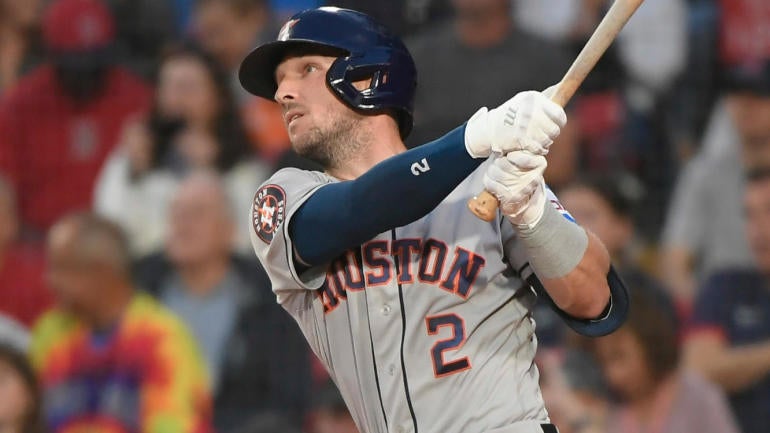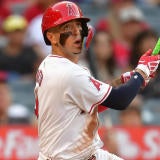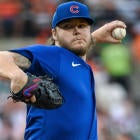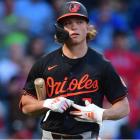
Fantasy Baseball leagues are anything but one-size-fits-all, and one of the core distinctions is what scoring format is used.
The two most cited here at CBS Sports are Head-to-Head and Rotisserie, and if you visit our rankings page, you'll find separate tabs for each. But rather than poring over all the names and finding the discrepancies yourself, perhaps you'd prefer to cut straight to the chase with a list of those whose value changes the most depending on format.
That's the idea behind my All-H2H and All-Roto teams. At each position, you'll find the most representative player for that format. It doesn't mean he's the best player for that format, but it does mean he's best suited for that format.
First, though, let's make sure we have our terminology straight, because it's a bit of a quagmire. When I refer to a Rotisserie league, I mean any that uses category-based 5x5 scoring. Some Head-to-Head leagues also do, particularly on sites like Yahoo, and so if you play in such a league, understand that the All-Roto team is the one that applies to you.
When I refer to a Head-to-Head league, on the other hand, I mean any that uses points-based Fantasy Football-style scoring, as is most popular here at CBS Sports. If you play in a points league that isn't technically Head-to-Head, understand that the All-H2H team is still the one that applies to you.
More accurately, these teams could be described as the All-Points and All-5x5 teams, and you'll notice I make ample use of that language as well.

Fantasy Football Today Newsletter
Know What Your Friends Don't
Get tips, advice and news to win your league - all from the FFT podcast team.
Thanks for signing up!
Keep an eye on your inbox.
Sorry!
There was an error processing your subscription.
All-H2H team
Based on standard CBS Sports scoring:
| Head-to-Head point values | ||||||||
| For hitters | | For pitchers | | |||||
Single | 1 | Walk | -1 | |||||
Double | 2 | Earned run | -1 | |||||
Triple | 3 | Hit | -1 | |||||
Walk | 1 | Hit batter | -1 | |||||
Caught stealing | -1 | Inning | 3 | |||||
Hit by pitch | 1 | Strikeout | 0.5 | |||||
Home run | 4 | Win | 7 | |||||
Strikeout | -0.5 | Loss | -5 | |||||
Run | 1 | Save | 7 | |||||
RBI | 1 | QS | 3 | |||||
Stolen base | 2 | | | |||||
This format is the more straightforward one. There's no need to balance categories. Virtually everything a player produces is of benefit to you, and the benefit isn't relative to what you already have. What makes it complicated is that you have to consider the full scope of a player's contributions rather than just the handful that matter to Rotisserie leagues. More overlooked stats like doubles, walks and strikeouts can be real differentiators for hitters. Pitchers often stand out simply by accumulating innings. In fact, pure accumulation is a big part of the Head-to-Head points equation since percentage stats like batting average, ERA and WHIP have no direct value.
Catcher
Adley Rutschman is the No. 1 catcher regardless of format, but he'll feel more like the No. 1 catcher in Head-to-head points leagues, giving you a clearer advantage over the rest of the position. Mostly, it's because of his plate discipline -- he had 92 walks to 101 strikeouts last year -- but also it's because his power shows up more in the form of doubles than home runs.
Honorable mention: Keibert Ruiz, WAS
First base
Yandy Diaz's low strikeout rate and high walk rate have long made him a points league standout, and while the gap was seemingly less last year as he set career highs in batting average and home runs -- two contributions that matter just as much for 5x5 scoring -- the fact he outperformed Bryce Harper, Pete Alonso and Vladimir Guerrero in Head-to-Head points per game pretty much says it all.
Honorable mention: Vinnie Pasquantino, KC
Second base
It's less about what Ketel Marte offers for this format than what he lacks for the other. At a position loaded with base-stealers, an essential contribution in 5x5 scoring, he's one of the few who doesn't make a worthwhile contribution. He's likely to out-homer most of them, though, and home runs are twice as valuable as stolen bases in this format.
Honorable mention: Jonathan India, CIN
Third base
One of the downsides to presenting this information in the form of a starting lineup is that one position may house two of the most representative players for a particular scoring format, and that's the case at third base with Alex Bregman and Max Muncy. As far as 5x5 leagues are concerned, Bregman falls short in home runs and Muncy in batting average, but their plate discipline more than makes up for it in points leagues. In fact, Bregman averaged as many points per game last year as Austin Riley (3.33), and Muncy (3.29) averaged more than Rafael Devers (3.26). It doesn't mean you should draft either ahead of Riley or Devers, but it does mean you don't need to try as hard for Riley or Devers.
Honorable mention: Max Muncy, LAD
Shortstop
With an AL-leading 94 walks last year, which amounted to a .401 on-base percentage in the second half, J.P. Crawford is yet another example of a player whose superlative plate discipline propels him to points league greatness, and in fact, his 2.99 point-per-game average last year was better than both Bo Bichette (2.90) and Xander Bogaerts (2.88). Of course, his career-high 19 homers, which more than doubled his previous high, also contributed to that number, and that part of his skill set is less established.
Honorable mention: Corey Seager, TEX
Outfield
Even as Juan Soto's batting average has suffered the past two years, it's been hardly a blip in points leagues because of how disciplined he is. To be fair, his walks exceeded his strikeouts by only three last year compared to the usual 40 or so, but it was still his third straight year atop the walk leaderboard.
Kyle Schwarber also walks a lot but has become such a liability for batting average the past two years, hitting a combined .207, that he makes for a near impossible fit in the early rounds of Rotisserie drafts, when building a batting average foundation is critical. Points leagues, which don't account for batting average, can better reward his 45-homer power. As for Steven Kwan, he's among the best at avoiding strikeouts, which at least in this format helps to make up for his lack of home runs.
Honorable mention: Jung-Hoo Lee, SF
Starting pitcher
The common thread among these pitchers is that they're high-volume. All five were in the top 15 in innings pitched last year. Logan Webb was of course No. 1 and is regarded as an ace in Rotisserie as well, but he's not the big bat-misser that other aces are, which can make him a difficult fit at his going rate. Strikeouts don't have the same impact in points leagues, being worth only half a point each, but a pitcher can make up for a lot of shortcomings in that format just by churning out innings, which are worth three points apiece.
One such shortcoming is ERA, and that's mainly where these other pitchers fall short in Rotisserie, to one extent or another. Aaron Nola and Mitch Keller both had an ERA over 4.00 last year, and all the innings can actually have a deleterious effect in Rotisserie if they serve to drag down a ratio stat like that one. Even if it's more like a mid-threes ERA, which is closer to what Framber Valdez and Logan Gilbert delivered last year, it's hard to claim the pitcher is an ace for 5x5 scoring, but that's how those two are regarded in points leagues. Other lower-end examples would include Chris Bassitt and Jose Berrios.
Relief pitcher
Saves are essential in 5x5 Rotisserie leagues, being one of just five pitching categories, but in Head-to-Head points leagues, all that matters are the points. And as points go, it turns out that a solid six-inning start is more lucrative. Starting pitchers with relief pitcher eligibility, then, tend to be elevated in points leagues, and I'm using Chris Paddack to represent them all because it seems like his relief pitcher eligibility is all the difference in him being drafted or not. Others RP-eligible starters like Cole Ragans, Michael King, Nick Pivetta and Ryan Pepiot are hot commodities in Rotisserie as well.
As for Clase, he's meant to represent how, for true relievers, saves are the only contribution of value in points leagues. Every three are worth the same as 40 strikeouts, basically. Clase isn't much for strikeouts, but there's no one threatening to bump him from the closer role in Cleveland, where, if history holds, he should rack up several dozen saves.
All-Roto team
Based on standard 5x5 categories (BA, HR, RBI, R, SB for hitters and W, ERA, K, WHIP, SV for pitchers)
Rotisserie leagues aren't simply an exercise in collecting the best, most productive players. You have to weigh what each player contributes across several categories and then strike the right balance across your entire roster. It's a quirk that leads to artificial scarcities, elevating a stat like stolen bases beyond its real-life utility. Efficiency is of greater concern, particularly on the pitching side, where 40 percent of what's scored is ERA and WHIP -- two stats with no direct value in Head-to-Head points leagues. Volume can actually be a detriment, then, if it negatively impacts those ratios.
Catcher
After hitting .306 with 25 homers in the minors two years ago, Yainer Diaz hit .283 with 23 homers as a rookie last year, which gives him the makings as a 5x5 stud as he steps into a starting role this year. But those contributions are undermined by a 2.9 percent walk rate in points leagues, where his batting average won't be fully appreciated either.
Honorable mention: Cal Raleigh, SEA
First base
Christian Encarnacion-Strand's case is much the same as Yainer Diaz's. From a 5x5 perspective, he's a breakout candidate who could make a massive contribution to the home run category, but his poor plate discipline gives him a much lower margin for error in points leagues. A part-time role in a crowded Reds infield would also be a death knell in that format, but not necessarily in this one.
Honorable mention: Ryan Mountcastle, BAL
Second base
You know how I said second base is loaded with base-stealers? Andres Gimenez is one of them, and while Ha-seong Kim and Bryson Stott also fit better for 5x5 leagues than points leagues, the former is able to narrow the gap some with walks and the latter with doubles. Gimenez is instrumental in this format but forgettable in points leagues.
Honorable mention: Nolan Gorman, STL
Third base
Josh Jung's near-30 percent strikeout rate is enough to render him ordinary in points leagues unless he significantly improves his power production. It also makes his batting average less than stable for 5x5 leagues, but he'll be piling up so many runs and RBI in the Rangers lineup that you'll hardly care. The honorable mention here is notable since it's a certifiable stud in Austin Riley, but his poor plate discipline makes him less dominant than you'd think in points leagues.
Honorable mention: Austin Riley, ATL
Shortstop
Bo Bichette's lack of walks has always held him back in points leagues, but now that it's clear batting average is his best characteristic, his power and speed contributions taking a step back the past couple years, you could argue he's not even deserving of an early-round pick in points leagues, where batting average has no direct impact on a player's production.
Honorable mention: C.J. Abrams, WAS
Outfielder
If you're allergic to walks but offer power and speed in some measure, 5x5 scoring is totally for you. That's clearly the case for Luis Robert and Michael Harris, and it makes about three rounds' difference early in drafts -- maybe even more for Harris, whose batting average contributions are wasted on points leagues. James Outman, meanwhile, suffers from the points league double whammy of striking out too much and sitting too often, but for Rotisserie purposes, it's hard to look past his combined 39 homers and steals last year.
Honorable mention: Teoscar Hernandez, LAD
Starting pitcher
While the All-H2H pitching staff was full of innings eaters with suspect ratios, the All-Roto pitching staff is just the opposite. These pitchers may not handle the workload you expect from an ace, but they'll be highly impactful with whatever innings they do throw. The clearest example is Tyler Glasnow, whose 120 innings last year, meager though they were, represented a career high. Inning for inning, he might be the most dominant pitcher this side of Spencer Strider and could do a world of good for your team's ratios even if he throws just 120 innings, but ratios aren't directly scored in points leagues. Hits are, walks are, and earned runs are, but enough innings can drown out all three.
And Glasnow's strikeouts aren't worth pursuing in points league either. It's not that they're without value. It's just that they're not nearly the differentiator they are in Rotisserie, where they represent one-quarter of a starting pitcher's entire contributions. Kodai Senga and Freddy Peralta are much more likely to give you 200 strikeouts than 200 innings, and that's a tradeoff you can accept easier in this format. Chris Sale could put a dent in the strikeout column, too, even if injuries end up costing him a significant portion of the season.
Eury Perez is a slightly different case. Like Glasnow, you can count on him being a ratios darling for whatever innings he does throw, but because he's still building up at this stage of his career, his starts could be on the shorter side. That's all the more damaging in points leagues, where quality starts are worth three points apiece.
Relief pitcher
You could argue that every closer is more valuable in a Rotisserie league since saves are non-essential in points leagues and teams start only two relievers, reducing the scarcity. But in particular, non-closers and even part-time closers are basically valueless in points leagues, while they're sometimes the best you can do in Rotisserie. I've chosen to highlight Robert Stephenson and Yuki Matsui here because they're likely to make some saves contribution in 2024, and even if that contribution is delayed or sporadic, they'll likely be of enough benefit in other categories for you to stick with them.





































































